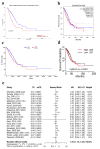Uses of Vascular Endothelial Growth Factor C as a Lung Adenocarcinoma Prognostic Biomarker
- PMID: 36896001
- PMCID: PMC9990733
- DOI: 10.14740/wjon1520
Uses of Vascular Endothelial Growth Factor C as a Lung Adenocarcinoma Prognostic Biomarker
Abstract
Background: Lung adenocarcinoma (LUAD) is the most common type of lung cancer and a leading cause of death worldwide. Vascular endothelial growth factor C (VEGF-C) has been identified as a prognosis prediction marker for LUAD. However, VEGF-C protein expression does not appear to significantly relate to LUAD patient survival in several studies.
Methods: We carried out a bioinformatic analysis to review the effect of VEGF-C mRNA expression on LUAD patient outcomes. GEPIA, UALCAN, TCGAportal, OncoLnc, LCE, GeneMANIA, Metascape, ImmuCellAI, and GSCA online databases were utilized. The expression levels of VEGF-C mRNA between normal tissue and LUAD tissue, overall survival (OS) analysis, function analysis, tumor microenvironment and drug sensitivity were conducted in the current study.
Results: We found that the expression level of VEGF-C mRNA was significantly lower in LUAD than normal tissue. Low expression of VEGF-C mRNA was also associated with better OS. VEGF-C expression was correlated with both NF1 and TP53 mutation status. No relationship was observed between VEGF-C and Tr1 or CD4 T-cell infiltrate scores. Additionally, VEGF-C was associated with epidermal growth factor receptor (EGFR) tyrosine kinase inhibitor resistance. The sensitivity of 5-fluorouracil was positively correlated with VEGF-C, and the sensitivity of TGX221 was negatively correlated with VEGF-C. The activity of BI-2536 and BRD-A94377914 was positively correlated with VEGF-C.
Conclusion: Novel LUAD prognostic biomarkers such as VEGF-C mRNA may aid diagnosis and treatment, and may help identify optimal LUAD populations for therapeutic treatments.
Keywords: Lung adenocarcinoma; P53; Survival; VEGF-C; mRNA.
Copyright 2023, Chen et al.
Conflict of interest statement
The authors declare that they have no competing interests.
Figures





References
-
- Kuhn E, Morbini P, Cancellieri A, Damiani S, Cavazza A, Comin CE. Adenocarcinoma classification: patterns and prognosis. Pathologica. 2018;110(1):5–11. - PubMed
-
- Ruiz-Patino A, Castro CD, Ricaurte LM, Cardona AF, Rojas L, Zatarain-Barron ZL, Wills B. et al. EGFR Amplification and Sensitizing Mutations Correlate with Survival in Lung Adenocarcinoma Patients Treated with Erlotinib (MutP-CLICaP) Target Oncol. 2018;13(5):621–629. doi: 10.1007/s11523-018-0594-x. - DOI - PubMed
LinkOut - more resources
Full Text Sources
Research Materials
Miscellaneous
